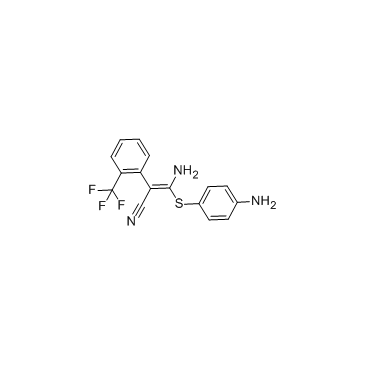305350-87-2
| Name | (Z)-3-amino-3-(4-aminophenyl)sulfanyl-2-[2-(trifluoromethyl)phenyl]prop-2-enenitrile |
|---|---|
| Synonyms |
(2Z)-3-amino-3-[(4-aminophenyl)sulfanyl]-2-[2-(trifluoromethyl)phenyl]prop-2-enenitrile
MEK1/2 Inhibitor HMS3229K18 SL327 (2Z)-3-Amino-3-[(4-aminophenyl)sulfanyl]-2-[2-(trifluoromethyl)phenyl]acrylonitrile (Z)-3-amino-3-(4-aminophenylthio)-2-(2-(trifluoromethyl)phenyl)acrylonitrile Benzeneacetonitrile, α-[amino[(4-aminophenyl)thio]methylene]-2-(trifluoromethyl)-, (αZ)- SL 327 |
| Description | SL327 inhibits MEK1 and MEK2, with IC50 values of 180 nM and 220 nM, respectively. |
|---|---|
| Related Catalog | |
| Target |
MEK1:180 nM (IC50) MEK2:220 nM (IC50) |
| In Vitro | The specificity of SL327 for MEK is investigated. Kinase activity is assessed by measuring the incorporation of [32P]phosphate during phosphorylation of substrate peptides specific for each kinase. Although SL327 inhibits MEK with an IC50 of 0.27 μM, 10 μM SL327 has no significant effect on PKA, CaMKII, or PKC[2]. |
| In Vivo | SL327, which crosses the blood-brain barrier, is administered intraperitoneally at several concentrations to animals prior to cue and contextual fear conditioning. Administration of SL327 completely blocks contextual fear conditioning and significantly attenuates cue learning when measure 24 hr after training. Animals treated with SL327 exhibit significant attenuation of water maze learning; they take significantly longer to find a hidden platform compared with vehicle-treated controls and also fail to use a selective search strategy during subsequent probe trials in which the platform is removed. Mice are injected with various concentrations of SL327 (10, 30, 50 mg/kg i.p.), and 1 hr later their hippocampi are removed and assayed for activated MAPK. SL327 attenuates phosphorylated MAPK levels in a dose-dependent manner. Administration of 10, 30, or 50 mg/kg SL327 significantly attenuates p42 phospho-MAPK levels (F=20.90, P<0.0001;10 mg/kg SL327 vs. vehicle, P<0.05, and 30 and 50 mg/kg SL327 vs. vehicle, P<0.001). Injection with 30 or 50 mg/kg SL327 also significantly reduces p44 phospho-MAPK levels (F=5.627, P<0.005;30 mg/kg vs. vehicle, P<0.05, and 50 mg/kg SL327 vs. vehicle, P<0.01)[2]. |
| Kinase Assay | Protein kinase assays are performed. All kinase assays are started by adding enzyme to a mixture that included [γ-32P]ATP and substrate. This mixture is then incubated at 30°C or 37°C for 10 min. The reaction is stopped by spotting aliquots of the reaction mixture onto Whatman P-81 phosphocellulose filter paper. The papers are then washed in 150 mM H3PO4, dried, and subjected to scintillation counting. The catalytic subunit of PKA is assayed by measuring [32P]phosphate incorporation into the substrate Kemptide (100 μM). The activity of CaMKII is determined by measuring phosphorylation of the synthetic peptide Autocamtide (100 μM) in the presence of 100 μM Calcium and 10 μg/mL Calmodulin. A synthetic peptide analog of a fragment of neurogranin, NG(28-43) (10 μM) is used as a specific substrate for the catalytic subunit of PKC. In all cases, substrate phosphorylation was linear with respect to time and enzyme concentration[2]. |
| Animal Admin | Mice[2] Adult male 129S3/SvImJ mice are used. In the 1×-pairing paradigm of cue and contextual fear conditioning, animals are placed in the fear conditioning apparatus for 3 min, then a 30-sec acoustic conditioned stimulus (CS; white noise, 80 dB) is delivered. During the last second of the CS, a 1-sec shock unconditioned stimulus (US; 0.5 mA) is applied to the grid floor. To assess contextual learning, the animals are returned to the training context 24 hr post-training, and freezing behavior is scored for 5 min. To assess cue learning, the animals are placed in a different context (novel odor, lighting, cage floor, and visual cues) following contextual testing. Baseline behavior is measured for 3 min in the novel context (Pre-CS), then the tone is presented for 3 min. Freezing behavior is assessed with a time sampling procedure whereby the animal was observed for ~1 sec every 5 sec. The experimenter is blind to drug treatment. Animals are injected with either vehicle (2 mL/kg, 100% DMSO) or SL327 (10, 30, and 50 mg/kg; at 2 mL/kg, dissolved in 100% DMSO) intraperitoneally 1 hr before training[2]. |
| References |
| Density | 1.4±0.1 g/cm3 |
|---|---|
| Boiling Point | 512.6±50.0 °C at 760 mmHg |
| Melting Point | 127-128.2ºC |
| Molecular Formula | C16H12F3N3S |
| Molecular Weight | 335.347 |
| Flash Point | 263.8±30.1 °C |
| Exact Mass | 335.070404 |
| PSA | 101.13000 |
| LogP | 1.95 |
| Appearance | solid | white |
| Vapour Pressure | 0.0±1.3 mmHg at 25°C |
| Index of Refraction | 1.631 |
| Storage condition | 2-8°C |
| Water Solubility | DMSO: 32 mg/mL |
| Personal Protective Equipment | Eyeshields;Gloves;type N95 (US);type P1 (EN143) respirator filter |
|---|---|
| RIDADR | NONH for all modes of transport |
| WGK Germany | 3 |
